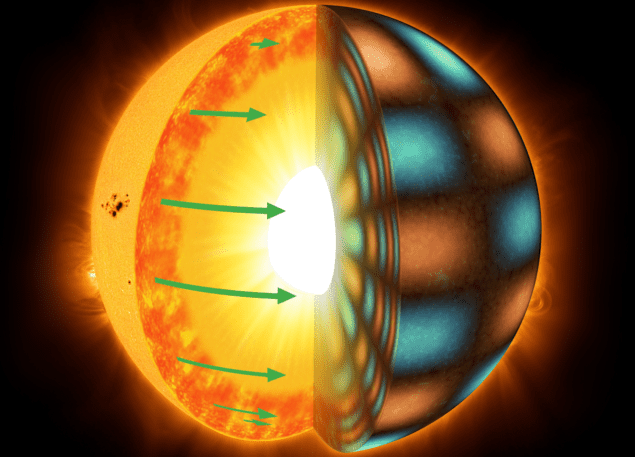Acoustic waves reveal that some stars spin faster at the equator than at the poles

An international team of astronomers has observed latitude-varying rotation in the outer layers of 13 Sun-like stars and shown in great detail that the Sun is not alone in displaying this curious behaviour. Othman Benomar at New York University, Abu Dhabi and his colleagues made the discovery by measuring distinctive patterns of acoustic oscillations in the stars. Their discovery could help to advance our understanding of the elusive mechanisms which play out deep within the Sun and other stars.
By observing the movements of sunspots across the Sun’s surface, astronomers have known for some time that our host star’s equator rotates 30% faster than its poles – a phenomenon known as “differential rotation”. More recent observations have revealed that this latitude-varying rotation occurs throughout the Sun’s convection zone, which extends to 200,000 km below its surface.
Differential rotation is believed to play a role in the Sun’s vibrant magnetic activity, which can sometimes affect Earth as solar storms. So far, however, astronomers have gained little understanding of the mechanisms that generate and sustain differential rotation.
Acoustic waves
To explore the effect further, Benomar’s team looked at differential rotation in other Sun-like stars using asteroseismology – the technique that originally revealed differential dynamics throughout the Sun’s convection zone. Asteroseismology involves analysing the resonant frequencies of the acoustic waves that form within the bodies of stars. The waves arise from the convective motion of material in the outer layers of stars. The precise nature of these waves depends upon the depth at which they travel. Furthermore, the frequencies of the waves are sensitive to latitude-varying rotation speeds. allowing researchers to accurately quantify differential rotation in different stars.
The astronomers made their observations using NASA’s Kepler Space Telescope – its capability for high-precision, long-duration measurements making the telescope ideal for performing asteroseismology on nearby stars. Overall, Benomar and colleagues searched for the resonant frequencies indicative of differential rotation in 40 stars with similar masses, temperatures, and compositions to our Sun. They inferred rotation speeds which varied strongly with latitude in 13 of the candidates, with the equators of some stars rotating around twice as fast as their mid-latitudes. Even in stars where the effect was less pronounced, the researchers identified no cases where equatorial rotations were slower than those in higher latitudes.
Although we know that latitude-varying rotation is not exclusive to the Sun, many questions remain about the origin of the phenomenon. The shear forces they observed in the convection zones of some stars were far stronger than those predicted by numerical simulations, suggesting our current theoretical models of stellar interiors are far from complete. The team’s observations could now inform studies aiming to understand the mechanisms underlying stars and their magnetic fields in greater detail.

Comments
Post a Comment